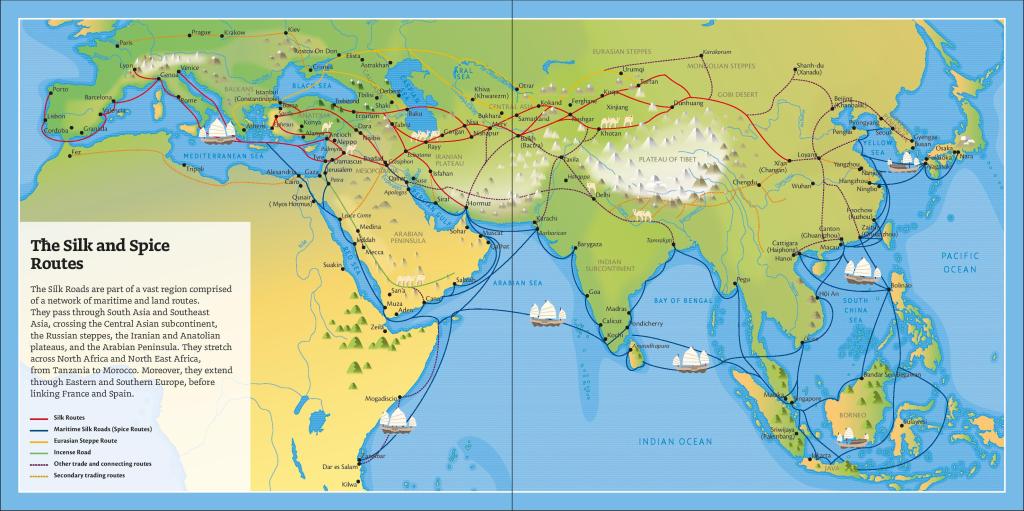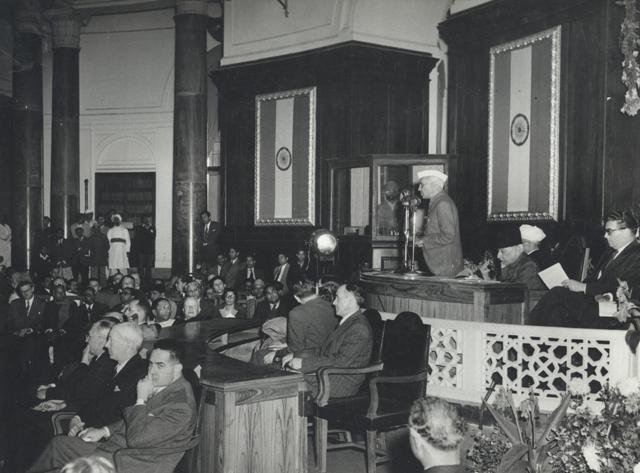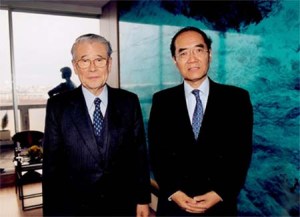‘Silk Roads’ is now a concept embraced by UNESCO, with the first transnational serial site as inscribed in 2014. Japan had played a vital role in the early discussion of Eurasian links which led to the adoption of the ‘Silk Roads’ term by UNESCO. I explored Japan’s role and the expanding remit of the ‘Silk Roads’ at the 2015 symposium, ‘Asia and Scandinavia: New Perspectives on Early Medieval Silk Roads.’ Japan was always concerned to ensure that the middle and the ends of this system — Central Asia and Japan — are not neglected. Given the growing voice of China in political, economic and cultural debates on the Silk Roads, it remains to be seen how successful they will be in this.

presents Japan and Korea as beyond the main ‘Silk Roads’ on ‘trade and connecting routes’.
The conference papers were recently published in The Bulletin of The Museum of Far Eastern Antiquities (81), edited by Eva Myrdal, and I take this opportunity to give brief extracts from my paper below.
“Generally — although mistakenly — first attributed to an 1877 publication by Baron Ferdinand von Richthofen (1833–1905), a German geographer with commercial interests in a proposed railway to connect Europe and China, the term ‘Silk Road’ is now commonly encountered both inside and outside academia.1 Yet it was hardly known until a few decades ago. Like many abbreviations, it is not strictly descriptive as James Millward points out, “neither silk nor a road.” (I would be inclined to rephrase this as “not only silk and not only a road.”)2 Nor should it be interpreted as restricting the discussion to the relations between two points, China and Rome, East and West, though it is often popularly presented in this dichotomous way.3 Lands (and seas and rivers) in between are just as much part of the story.(Central Asia; South, Southeast, and West Asia; Africa), all involved in the interregional movement of goods and ideas.4 The Silk Road story cannot be told without their involvement, yet, despite their geographical centrality, they have often been treated as peripheral to the empires on their borders.5 While the term ‘Silk Road’ has now become ubiquitous, some scholars have argued recently for its rejection because of these simplifications and because of its use in a more widespread popular context.6 The adoption of the term, its original scope and challenges to it have been explored elsewhere and will not be repeated here.7
“UNESCO was founded in 1946 and was from the start interested in
the historic and cultural links across Afro-Eurasia, although framing this in dichotomous terms—East/West, Orient/Occident.8 In 1951 it convened the Plenary Session of a symposium in New Delhi, entitled “Concept of Men and Philosophy of Education in East and West.” In his closing address, Jawaharlal Nehru (1889–1964), then Prime Minister of India, expressed his dismay at the dichotomous nature in which this agenda was worded: “I have always resisted this idea of dividing the world into the Orient and the Occident.”

‘Concept of Men and the Philosophy of Education in the East and West’, New Delhi, Dec. 20, 1951.
“His opinion was not the consensus however and a ten-year major project followed in 1956 on the “Mutual Appreciation of Eastern and Western Values.” The joint-declaration argued for an understanding of the exchanges between east and west based on history.9 The project was promoted by the Indian and Japanese members. The Japanese remained very active.10 In 1957 at the “International Symposium on the History of East West Cultural Contacts,” the Japanese National Commission to UNESCO presented a survey of the extensive Japanese scholarship in this field. The term ‘Silk Road’ was noted in this report to name “the international route of ancient times that passed through this area [Central Asia] from east to west.”11 It credited the German geographer Albert Herrmann (1886–1945) with coining the name.
This interest was not new: as the 1957 report makes clear, the desire to search for the roots of Japanese culture in China, India, Central Asia and even further west had driven the expeditions of Count Ōtani earlier in the century. Reports of European explorers contemporary with Ōtani, such as Sven Hedin, were translated into Japanese using various terms for ‘Silk Road’.12 By the 1960s the transliterated term Shiruku rōdo had become the most common.
The Japanese report of 1957 made a division into three intercultural routes between east and west—steppe, oasis and maritime. It stressed the importance of Central Asia, noting that “it should not merely be interpreted as a ‘corridor’ between China and Western Asia.”13 Also, in a point possibly picked up from Herrmann’s work, it argued that the contact with the steppe and the Tibetan plateau were “equally as, or even more remarkable, than contact with China.” One of the stated aims of the report was to broaden the ‘Silk Road’ to challenge “the traditional self-superior attitude of the Chinese.”14
Tourism to foreign countries in Japan, restricted in the post-war period, was fully liberalised from 1964 and grew throughout the 1970s. But political events in China made travel there difficult at this time. However, by the 1980s Japanese had started travelling to sites in north-western China, many inspired by the ten-part documentary, “The Silk Road”. This aired in 1980, jointly produced by the Japanese and Chinese national broadcasters. Among these early travellers was Hirayama Ikuo (1930–2009), a collector and painter of Silk Road themes. He became a UNESCO Goodwill Ambassador in 1989.

Japan, which had been so active at the start of the process, continued to play a role. One of the signatories of the letter calling for the inscription of the ‘Silk Road’ as a World Heritage site was Hirayama. As well as travelling much of the Silk Road and using it to inspire his own paintings, he funded cultural heritage projects at Dunhuang, Bamiyan and elsewhere, as well as offering fellowships to Silk Road scholars. In 1990, he established the “Institute for Silk Road Studies” in Kamakura to encourage scholarship through research projects, conference and an academic journal. The Institute was closed in 2004 but Hirayama then opened his Silk Road Museum to display his collections and own paintings.
In their 1957 report, the Japanese had discussed the tendency for early scholarship in Japan to centre on China. The emphasis in the report on the importance of the steppe and of Central Asia was clearly an attempt to ‘reorient’ scholarship from what was seen as a Sino-centric bias. This concern continued. In 1989 the Japanese government deposited funds in UNESCO: “The Japanese Funds-in-Trust for the Preservation of the World Cultural Heritage.” These have been used for various projects connected with the Silk Road, notably two to help Central Asian countries prepare the UNESCO documentation for their corridor bids.15 In fact the 2003 Mission to China had considered a case study proposing that the initial nomination came from China alone.16 However, after the 2006 Mission, the recommendation had changed to a transnational nomination within a timescale of two to three years. The nomination did not appear, and Japanese funding was given in 2011 to assist the Central Asian countries in this process, leading to the first transnational Silk Road inscription in 2014. This is the ‘Chang’an-Tianshan Corridor‘, a route through China, Kazakhstan and Kyrgyzstan.”
Japan is not itself currently part of any of the proposed ‘Silk Road corridors’, despite its attempts to get Nara accepted as the eastern end.17 It continues to try to stress Japan’s role in the UNESCO activities seen for example, in a 2014 conference which included a keynote lecture on “Japan’s Contribution to the Inscription of the Silk Roads as a World Heritage Site” and a panel discussion on “The Silk Roads and Japan.”18 It also continues a very active programme of scholarship to support this process.“
China, meanwhile, has also embraced the Silk Road concept, realizing its political and economic potential for orienting itself as a modern world power. In 2013, the year before its Silk Road nomination was inscribed, China announced its own initiatives, “The New Silk Road Economic Belt” and “The 21st Century Maritime Silk Road.” These are now known as the “Belt Road Initiative” (BRI).
It remains to be seen how much it will affect the continuing Sino-centric bias of much of Silk Road scholarship which Japan, for one, tried to steer UNESCO away from.”

This article takes the story to the PRC’s growing involvement in the UNESCO agenda. I am now expanding this research as part of my involvement in the project, Nara to Norwich: Art and Belief at the Extremities of the Silk Roads, 500-1000. I will be looking at how BRI and other Silk Road narratives are influencing cultural heritage policy and understanding, especially in Japan and Korea.
NOTES
1 Matthias Mertens has recently shown that the term was used in German literature prior to this. See “Did Richthofen Really Coin ‘the Silk Road’?” The Silk Road 17 (2019 [2020]). Chin discusses the adoption of the term by Sven Hedin and the start of its wider usage from the 1930s. See Tamara Chin, “The Invention of the Silk Road, 1877,” Critical Inquiry 40.1 (Autumn 2013): 194–219. Also see Daniel C. Waugh, “Richthofen’s ‘Silk Roads’: Toward the Archaeology of a Concept,” The Silk Road 5.1 (2007): 1–10 and “Sven Hedin and the Invention of the Silk Road,” (paper presented at the Sven Hedin and Eurasia symposium, Stockholm, Sweden, Nov. 10, 2007). The term started coming into general usage in Europe and the United States in the late 1980s, as I showed in a previous discussion, Susan Whitfield, “Was There a Silk Road?” Asian Medicine 2 (2007): 201–213.
2 James A. Millward, The Silk Road: A Very Short Introduction (Oxford: University Press, 2013). 3. Bloom has argued for ‘Paper Road’ on the grounds of its influence, Jonathan M. Bloom, “Silk Road or Paper Road?” The Silk Road 3.2 (2005): 21–26. I have no problem with the term “road” or “roads,” taking them in a broad sense to mean marked routes along which people and goods travel. But we have also to take into account routes
across the steppe, which might not follow any single route, and routes across the sea.
3 Dichotomies simplify our view of a complex world and are therefore always seductive, if inevitably misleading and distorting. See Victor Lieberman, “Transcending east-west dichotomies: State and culture formation in six ostensibly disparate areas,” Modern Asian Studies 31:3 (1997): 463–546 and Susan Whitfield, “The Perils of Dichotomous Thinking: Ebb and Flow Rather than East and West,” in Marco Polo and the Encounter of East and West, ed., Suzanne Akbari, and Amilcare A. Iannucci (Toronto: University of Toronto Press, 2008), 247–261. Chin discusses how Hedin stated this dichotomy in his vision of a new Silk Road: “It should unite two oceans, the Pacific and the Atlantic; two continents; two races, the yellow and the white; two cultures, the Chinese and the Western,” Chin, The Invention of the Silk Road, 217, quoting Sven Hedin, The Silk Road, trans., F. H. Lyon (New York: E. P. Dutton 1938), 223, 233, 234. The background to the UNESCO interest in the Silk Road, discussed below, is firmly based within a dichotomous framework, as discussed by Laura Elizabeth Wong, “Relocating East and West: UNESCO’s Major Project on the Mutual Appreciation of Eastern and Western Cultural Values,” Journal of World History 19.3 (2008): 353–358.
4 Including silk, since it was only in the early centuries of Silk Road history that China maintained the monopoly on cultivated silk production. It had spread into Central Asia by the first few centuries CE. For a summary of the development of silk production along the Silk Road see Susan Whitfield, Silk, Slaves and Stupas:Material Culture of the Silk Road (Oakland: University of California Press, 2018), Chapter 8.5 There is also the issue of being labeled a ‘peripheral’ trading partner in the framework of World Systems
Theory. This is not something I explore here but see the papers in Kristian Kristiansen, Thomas Lindkvist,
and Janken Myrdal, eds., Trade and Civilization in the Pre-Modern World (Cambridge: Cambridge University
Press, 2018), for discussion and alternative models. The issue with using ‘periphery’ is that it assumes a core
and is, even if meant descriptively—as in geographical terms—a loaded term
6 In Warwick Ball’s words, it has “become both a band wagon and a gravy train,” in The Monuments of Afghanistan: History, Archaeology and Architecture (London: I. B. Tauris, 2007), 80. Hugh Pope calls it “a romantic deception,” in “The Silk Road: A Romantic Deception?” The Globalist (24 November 2005). See also Khodadad Rezakhani, “The Road That Never Was: The Silk Road and Trans-Eurasian Exchange,” Comparative Studies of South Asia, Africa and The Middle East 30.3 (2010): 420–433 and M. G. Raschke, “New Studies in Roman Commerce with the East,” in Aufstieg und Niedergang der Romanischen Welt 2.9 (Berlin and New York: de Gruyter, 1978): 604–1378. Nagasawa Kazutoshi notes that it was used for “many vulgar books which offended academic people,” in “Silk Road Studies in Japan: its history and present situation” (International Seminar for UNESCO Integral Study of the Silk Roads: Roads of Dialogue, Osaka, Japan, 1988).
7 See Susan Whitfield, Life Along the Silk Road (Oakland: University of California Press, 2015), Introduction,
for a recent discussion.
8 As Wong points out, this dichotomy was found in the 1946 publication of UNESCO’s first Director General,
“Relocating,” 353.
9 UNESCO General Conference Resolution 4.81, Ninth General Conference, 1956. For the political background leading to this and a fuller discussion see Wong, “Relocating”. I am indebted to her work for this summary.
10 Not so much the Indians who, as Wong notes, became distracted by border wars, “Relocating,” 353.
11 Japanese National Commission for UNESCO, Research in Japan in History of Eastern and Western Cultural Contacts: its development and present situation (Tokyo: UNESCO, 1957), 6.
12 Hedin’s work was translated as early as 1939 by Takayama Yōkichi with the title: 赤色ルート踏破記. (Walking Along the Red Route), Tokyo: Ikuseisha, Shōwa 14. Incidentally, the term ‘red route’ was one used earlier in the century to refer to a proposed railway through British territory in Canada to link to routes to Asia, the ‘red’ referring to Britain in this case, see R. Douglas Francis, Richard Jones and Donald B. Smith, Journeys: A History of Canada (Boston: Cengage, 2009), 284. More pertinent perhaps is its use in the title of a Japanese book, published in 1938 by the political organisation Shinminkai (新民会) that had been founded in
occupied North China with Japanese support (民衆把握戰ニ於ケル「支那赤色ルートノ槪況」. (Beiping: Xin min hui zhong yang zhi dao bu diao cha ke, Minguo 27 [1938]).
13 The term corridor continues to be used in UNESCO and is now commonly found in the discussions of
China’s ‘Belt Road Initiative’ (BRI). See below.
14 Japanese National Commission, Research, 8.
15 UNESCO, “Silk Roads World Heritage Serial and Transnational Nomination in Central Asia: A UNESCO/
Japanese Funds-in-Trust Project,” http://whc.unesco.org/en/activities/825/ and a follow up, “Support for Silk
Roads World Heritage Sites in Central Asia (Phase II),” http://whc.unesco.org/en/activities/870
16 See Jing and Oers, UNESCO Mission. Interestingly this considered the Xi´an to Kashgar route and proposed a conservation management plan for Kashgar. When China joined in a transnational nomination, the route nominated bypassed Kashgar, avoiding recent debate about its conservation. See Yan Haiming, “World Heritage and National Hegemony: The Discursive Formation of Chinese Political Authority,” in A Companion to Heritage Studies, ed., William Logan, Miread Nic Craith, and Ullrich Kocel (London: John Wiley and Sons, 2015), 229–242 (235–8).
17 The decision to make Xi’an in China the eastern end was made at the 2007 “International Symposium for the Serial Nomination for the Silk Roads to the World Heritage”, held in Xi’an. A Japanese report notes “unfortunately, Nara was excluded from this Silk Roads in the nomination. From the side of Japan, it is considered quite essential to keep discussing, in the nomination process, the geographical and historical definitions of the Silk Roads.” See Yamauchi Kazuya, “International Symposium for the Serial Nomination for the Silk Roads to the World Heritage,” Tobunken Monthly Report 11 (2007). http://www.tobunken.go.jp/materials/ektauthor/yamauchi-kazuya. The 2014 ICOMOS report recommends further work on drawing in other areas, and includes “the eastern extent of the routes, into Korea and Japan” in this. See Williams, The Silk Roads, 63.
18 Inouchi Chisa, “The Silk Roads as a World Heritage Site: Tracing the Origins of Japan’s International Cooperation in Cultural Heritage,” Tobunken Monthly Report 27 (September 2014). http://www.tobunken.go.jp/materials/ekatudo/205940.html?s=silk+road

Pingback: How Did Religion Spread Along the Silk Road? Crash Course Geography #31 - Max STEAMaker
Apan is not itself currently part of any of the proposed ‘Silk Road corridors’, despite its attempts to get Nara accepted as the eastern end.
LikeLike
Pingback: How Did Religion Spread Along the Silk Road? Crash Course Geography #31 - Udemyskillshare